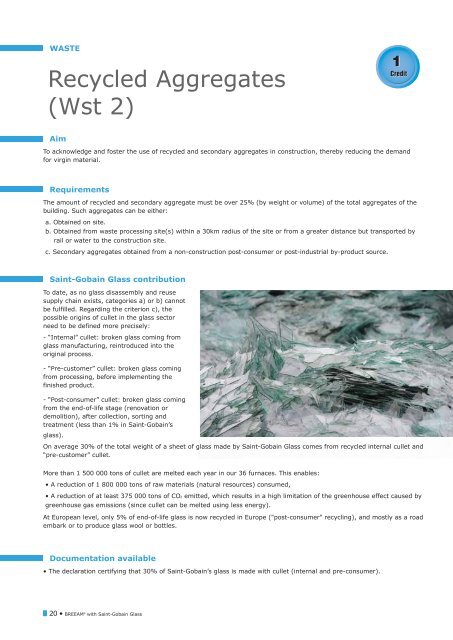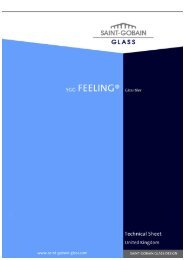For a sustainable habitat - Saint-Gobain Glass Nordic
For a sustainable habitat - Saint-Gobain Glass Nordic
For a sustainable habitat - Saint-Gobain Glass Nordic
You also want an ePaper? Increase the reach of your titles
YUMPU automatically turns print PDFs into web optimized ePapers that Google loves.
WASTE<br />
Recycled Aggregates<br />
(Wst 2)<br />
Aim<br />
To acknowledge and foster the use of recycled and secondary aggregates in construction, thereby reducing the demand<br />
for virgin material.<br />
Requirements<br />
The amount of recycled and secondary aggregate must be over 25% (by weight or volume) of the total aggregates of the<br />
building. Such aggregates can be either:<br />
a. Obtained on site.<br />
b. Obtained from waste processing site(s) within a 30km radius of the site or from a greater distance but transported by<br />
rail or water to the construction site.<br />
c. Secondary aggregates obtained from a non-construction post-consumer or post-industrial by-product source.<br />
<strong>Saint</strong>-<strong>Gobain</strong> <strong>Glass</strong> contribution<br />
To date, as no glass disassembly and reuse<br />
supply chain exists, categories a) or b) cannot<br />
be fulfilled. Regarding the criterion c), the<br />
possible origins of cullet in the glass sector<br />
need to be defined more precisely:<br />
- “Internal” cullet: broken glass coming from<br />
glass manufacturing, reintroduced into the<br />
original process.<br />
- “Pre-customer” cullet: broken glass coming<br />
from processing, before implementing the<br />
finished product.<br />
1<br />
Credit<br />
- “Post-consumer” cullet: broken glass coming<br />
from the end-of-life stage (renovation or<br />
demolition), after collection, sorting and<br />
treatment (less than 1% in <strong>Saint</strong>-<strong>Gobain</strong>’s<br />
glass).<br />
On average 30% of the total weight of a sheet of glass made by <strong>Saint</strong>-<strong>Gobain</strong> <strong>Glass</strong> comes from recycled internal cullet and<br />
“pre-customer” cullet.<br />
More than 1 500 000 tons of cullet are melted each year in our 36 furnaces. This enables:<br />
• A reduction of 1 800 000 tons of raw materials (natural resources) consumed,<br />
• A reduction of at least 375 000 tons of CO2 emitted, which results in a high limitation of the greenhouse effect caused by<br />
greenhouse gas emissions (since cullet can be melted using less energy).<br />
At European level, only 5% of end-of-life glass is now recycled in Europe ("post-consumer" recycling), and mostly as a road<br />
embark or to produce glass wool or bottles.<br />
Documentation available<br />
• The declaration certifying that 30% of <strong>Saint</strong>-<strong>Gobain</strong>’s glass is made with cullet (internal and pre-consumer).<br />
20 • BREEAM® with <strong>Saint</strong>-<strong>Gobain</strong> <strong>Glass</strong>




